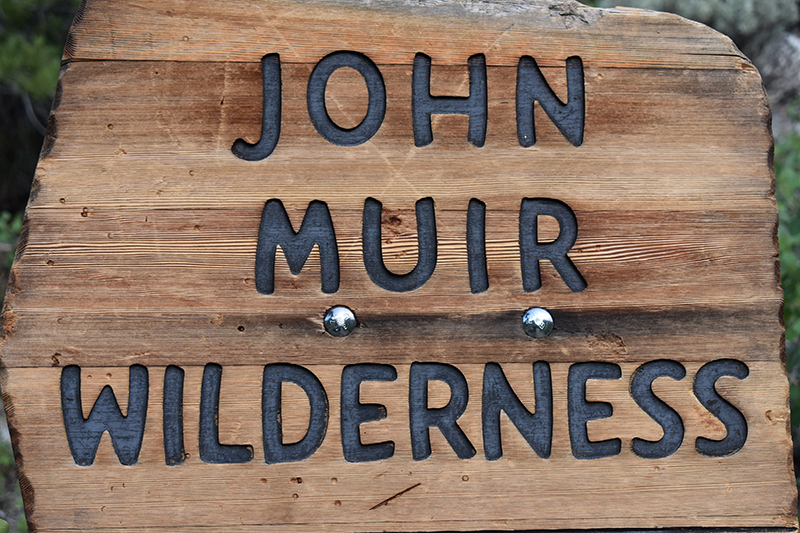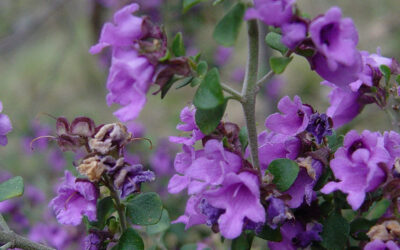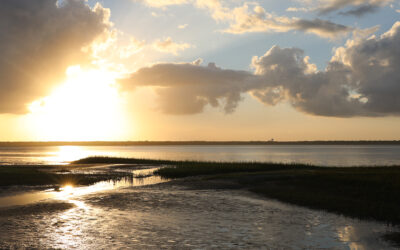View of Long Lake in the John Muir Wilderness, Inyo National Forest, California, USA. Photo credit © Larry Beck.
Interpreting John Muir’s Legacy
Soul of the Wilderness
April 2021 | Volume 27, Number 1
Climb the mountains and get their good tidings. Nature’s peace will flow into you as sunshine flows into trees. The winds will blow their own freshness into you, and the storms their energy, while cares will drop off like autumn leaves.
– John Muir
Jennifer Ladino (2019) begins Memorials Matter with this quote by John Muir, noting how he inspired seemingly countless national park professionals through his passion for nature. Similarly, Ken Burns in his 12-hour documentary, The National Parks, begins and ends with quotes by Muir. Often called “the father of the national parks,” Muir shared his enthusiasm for wildness with generations of Americans, and his political influence helped protect many iconic parks such as Yosemite and Grand Canyon, and much of the land that later became wilderness in the American West.
Muir’s stature as a historic figure can be measured in part by the number of objects named in his honor. The list includes 21 elementary schools, 6 middle schools, 1 high school, 1 college, a glacier, a mountain, an inlet, a highway, a library, a medical center, and a minor planet (Nobel 2016). Add to this California’s 210-mile (338-km) John Muir Trail, John Muir Wilderness, and two sites administered by the National Park Service: Muir Woods National Monument and John Muir National Historic Site (Figure 1 and 2). His figure appears on the 2005 California commemorative quarter, along with Yosemite Valley’s Half Dome and the California Condor, celebrating the most beloved of the state’s ambassadors.
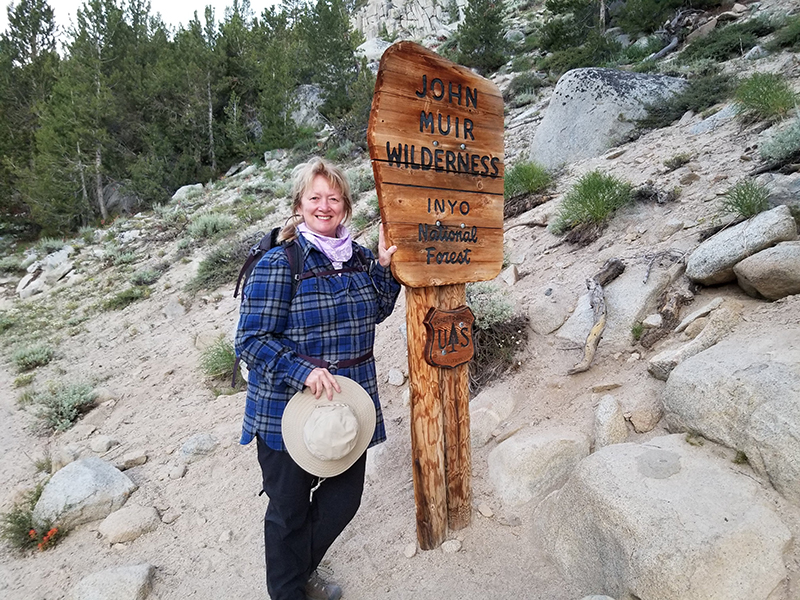
Figure 1 – Day hiker entering the John Muir Wilderness, Inyo National Forest, California, USA. Photo by Larry Beck.
Muir is revered for his eloquent and powerful language in support of wild nature and species other than our own. He was outspoken in driving the politics of his time toward conservation. He took personal and political chances in broadcasting his love for the outdoors. His passion for life was infectious.
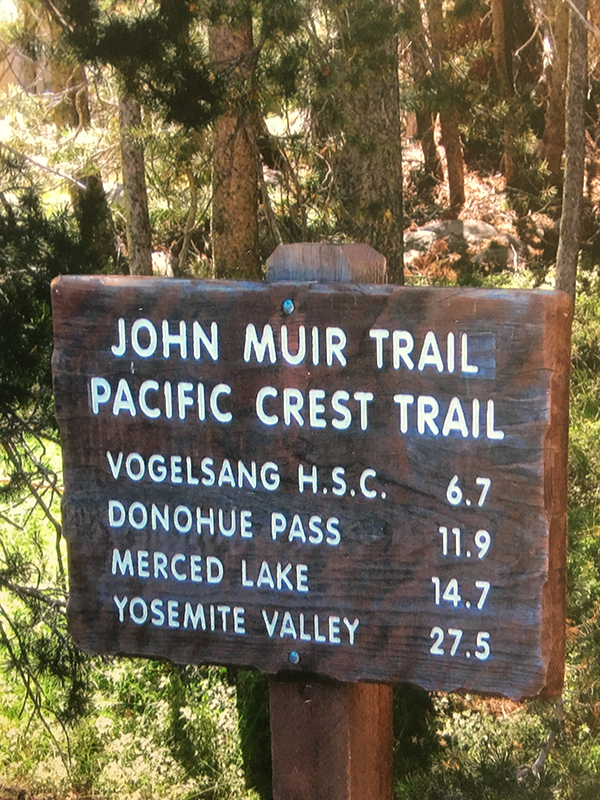
Figure 2 – The popular 210-mile (338-km) John Muir Trail passes through some of the most outstanding wilderness in the world; trail sign located in Yosemite National Park, California, USA. Photo by Vicki Fielden.
John Muir’s Racist Past
Recently, however, in the aftermath of the killing of Black American George Floyd in Minnesota and a nationwide flood of vehement protests, Muir’s racist past surfaced, along with animosity toward several other notable individuals. Monuments to Christopher Columbus, Father Junipero Serra, and other historic figures whose backgrounds aligned with the subjugation of Black Americans and Indigenous peoples, were toppled. Other monuments that were defaced or removed included those to confederates Jefferson Davis, Robert E. Lee, Stonewall Jackson, and Thomas Ruffin. Well-known commercial brands (for example, Aunt Jemima portraying a racist stereotype), university buildings (for example, the Wilson School of Public Policy at Princeton University because Woodrow Wilson had segregationist views), and sports teams (for example, the generic Washington Football Team – until a new name is chosen – formerly the Washington Redskins, a term demeaning to Indigenous peoples) were renamed as part of a national reckoning.
In July of 2020, news sources across the nation reported that the Sierra Club, which Muir cofounded in 1892, realized it was time for “truth-telling” about Muir’s past (see Grad 2020; Tompkins 2020). Michael Brune, the Sierra Club’s executive director, wrote a post on the organization’s website detailing Muir’s racist sentiments along with white supremacist beliefs of some of the club’s original members.
Although Muir focused most of his writing on the glories of nature, parts of his work characterized Black Americans and Indigenous peoples negatively. As Brune (2020) stated, “He made derogatory comments about Black people and Indigenous peoples that drew on deeply harmful racist stereotypes.” In addition to Muir, Brune acknowledged that other early Sierra Club members and leaders, such as Joseph LeConte and David Starr Jordan, were advocates for white supremacy and eugenics, indicating that “Muir was not immune to the racism peddled by many in the early conservation movement.” Indeed, some of Muir’s writings from his thousand-mile trek through the South to the Gulf of Mexico described Black Americans as “dirty” and “irresponsible.” At the same time, Muir also sympathized with some of those he met and bemoaned “the bigoted mindset he encounter[ed] amongst whites” (Nobel 2016). In California, Muir referred to California Indians as “lazy,” “superstitious,” and “garrulous as jays” (Nobel 2016). His perspective now seems particularly ironic because he carried a personal spirituality about the wonders of nature like that of native cultures.
Muir’s racist remarks were made early in his adult life. Later, in his travels to Alaska, he spent time with various native tribes and came to admire their lifestyles and culture (Fleck 1978). In Travels in Alaska, Muir described sitting around a campfire and how “the brightness of the sky brought on a long talk with the Indians about the stars.” He further commented that their enthusiasm was “refreshing to see as compared with the deathlike apathy of weary town-dwellers, in whom natural curiosity has been quenched in toil and care and poor shallow comfort” (see Teale 1954, p. 272). Muir evolved in his thinking about American Indians and “came to admire their stewardship of the land and expressed concern about the cruel ways they were treated” (Grad 2020).
Of course, we can’t ignore Muir’s racist comments. We can grow and forgive, but we don’t want to obscure or ignore. Still, Muir provides an important lesson, especially in the context of current racial tensions. His beliefs about Indigenous peoples changed because of his direct exposure to them. One of the greatest challenges of prejudice is that those who are blinded by it do not have any meaningful connection to those they disparage. Muir demonstrated change as he became more familiar with, and more knowledgeable about, the original inhabitants of the lands he loved. He learned what he had in common with native peoples and his perspective changed.
The Sierra Club’s Apology
The Sierra Club has accepted full responsibility for the overall early history of the organization. Brune (2020) acknowledged the “whiteness and privilege of our early membership.” Like private clubs that exist to this day, club membership was possible only through sponsorship from existing members, with applicants of color often screened out. Furthermore, Brune (2020) detailed the failure of many to acknowledge “the reality that the wild places we love are also the ancestral homelands of Native peoples, forced off their lands in the decades or centuries before they became national parks.”
Gessner (2020, p. 86) adds that “many of the lands we would come to call ‘wilderness’ were in fact landscapes that humans had manipulated and manicured by farming and fire for hundreds of generations. They were also lands that were extensively used as hunting grounds, summer grounds, winter grounds.” For this very reason, the environmental historian William Cronon (1995) pointed out, “The myth of wilderness as ‘virgin’ uninhabited land has always been especially cruel when seen from the perspective of the Indians who had once called that land home.” Hikers and other backcountry enthusiasts are provided the illusion that they are experiencing the United States in its pristine and original state (Cronon 1995).
The Sierra Club’s admission was intended to stimulate further conversation. In the meantime, Brune (2020) apologized for the club’s early history, noting the harm the organization “has caused, and continues to cause, to Black people, Indigenous people, and other people of color.” He continued, “I am deeply sorry.” The club’s commitment to change is expected to include a redesign of its leadership structure to include more leaders of color. The Sierra Club is also proposing a $5 million budget shift in the coming year, and with more funding in future years, to invest in staff of color and pursue racial and social justice work. Finally, the organization will spend time in a soul search scrutinizing its history. The Sierra Club sees this as a process that will take years to “regain trust from the communities we have harmed and create a diverse and equitable Sierra Club for the 21st century” (Brune 2020).
Interpreting John Muir’s Legacy
The Sierra Club is to be commended for acknowledging the bleaker side of John Muir, other early club activists, and how that history has influenced who enjoys nature to this day. Clearly, there is work to be done. Yet as we reflect on Muir’s legacy, we wonder if he would have progressed even further in his thinking had he acknowledged his shortcomings just as the Sierra Club is doing now. Might his contributions have expanded, just like the Sierra Club’s, from a parochial view of humankind’s place in the natural world to a more global perspective focused on social and environmental justice?
Having said this, to what degree should we judge Muir based on present day ethics and moral standards? Muir was a product of his times. In her pictorial biography of Muir, Gretel Ehrlich (2000, p. 221) noted that Muir lived at a time “of 19th century values, which held that expansion, industry, human dominance, and profit constituted the primary good.” Muir had the courage to challenge that line of thought. Other icons of the environmental movement had their questionable sides as well. Aldo Leopold shot a wolf, and then – watching the fierce green fire die in its eyes – experienced an epiphany that would lead to his articulation of the most important environmental ethic of our time (see Leopold 1949). Charles Melville Scammon was a ruthless whaling captain who drove the gray whale close to extinction. Yet later in life he became a renowned naturalist elected to the California Academy of Sciences. He wrote with a naturalist’s flair for the Overland Monthly, along with Muir and Jack London, becoming a champion of gray whales (Beck 2020).
Muir influenced how his own generation, and others that have followed, can see nature in a more enlightened way. His life’s work resulted in an evolution of American attitudes toward wilderness, major tracts of land set aside, policies designed to protect nature and all its inhabitants, and inspiration for countless nature enthusiasts. It is for these reasons that, despite his flaws, Muir remains relevant, perhaps even more so now than ever, as we grapple with environmental setbacks.
In judging Muir’s legacy, we should be compelled to look inward, admit our own shortcomings, and acknowledge that we, too, have been participants in a system that oppresses Black Americans, Indigenous peoples, and other people of color. We need to understand that whiteness and privilege provide insulation from systemic racism, affording the dominant culture time, energy, and the luxury of enjoying wildlands in a way marginalized people have not. In owning up to our complicity, we can become better versions of ourselves.
Tributes to John Muir, including all those entities that have been named after him, were not intended to celebrate the racism he portrayed earlier in his life. Those tributes exist because he deeply understood the beauty, wonder, and value of nature in our lives (Figure 3). Furthermore, Muir not only devoted his life to experiencing the wild places he loved so much, but he also acted in word and deed to protect those places in perpetuity for the benefit of everyone.
In judging Muir’s legacy, we should be compelled to look inward, admit our own shortcomings, and acknowledge that we, too, have been participants in a system that oppresses Black Americans, Indigenous peoples, and other people of color.
Yes, John Muir was imperfect, and this aspect of his being should be acknowledged. The importance of a national narrative rooted in historical and scientific integrity demands it. The Sierra Club has now acknowledged Muir’s racial injustice and has apologized for it. Telling the truth – the whole truth – may begin the process of healing for everyone, especially those who have been harmed by the wrongdoing. A focus on everyone is essential because our democratic way of life is only real if it respects the rights of all citizens. As we evaluate Muir’s legacy, we must recognize that love is the antidote to hate, and that it calls us to higher levels of tolerance and forgiveness.
In Leave It As It Is, a book that provides a deeper and more truthful interpretation of the life of another venerated environmentalist, Theodore Roosevelt, Gessner (2020, pp. 103-104) writes, “What TR left us with … was a story of wildness. It’s a damn good story … there are flaws in the story, some due to the times he lived in and some due to his own biases. Roosevelt is dead, and so he can’t revise his story. That is up to us. We need to tell a new story about wilderness for a new time.” The same can be said of John Muir. Let’s celebrate the good he did while acknowledging his flaws. Let’s take this opportunity to have conversations, build consensus, and incorporate diversity, all while remembering that his, too, was a damn good story.
About the Authors
LARRY BECK is a professor in the L. Robert Payne School of Hospitality and Tourism Management at San Diego State University; email: lbeck@mail.sdsu.edu.
DAN DUSTIN is a professor in the Parks, Recreation, and Tourism Program at the University of Utah: email: daniel.dustin@health.utah.edu.
References
Beck, L. 2020. The parable of the gray whale: Protecting species other than our own. Legacy 31(4): 36–39.
Brune, M. 2020. Pulling down our monuments. https://www.sierraclub.org/michael-brune/2020/07/john-muir-early-history-sierra-club, accessed July 22, 2020.
Cronon, W. 1995. The trouble with wilderness. http://www.williamcronon.net/writing/Trouble_with_Wilderness_Main.html, accessed August 10, 2020.
Ehrlich, G. 2000. John Muir: Nature’s Visionary. Washington, DC: National Geographic.
Fleck, R. 1978. John Muir’s evolving attitudes toward Native American cultures. American Indian Quarterly 4(1): 19–31.
Gessner, D. 2020) Leave It as It Is: A Journey Through Theodore Roosevelt’s American Wilderness. New York: Simon & Schuster.
Grad, S. 2020. Sierra Club calls out the racism of John Muir. Los Angeles Times. July 22, 2020. https://www.latimes.com/california/story/2020-07-22/sierra-club-calls-out-the-racism-of- john-muir, accessed July 22, 2020.
Ladino, J. 2019. Memorials Matter: Emotion, Environment, and Public Memory at American Historical Sites. Reno: University of Nevada Press.
Leopold, A. 1949. A Sand County Almanac. New York: Oxford University Press.
Nobel, J. 2016. The miseducation of John Muir. Atlas Obscura. July 26, 2016. https://www.atlasobscura.com/articles/the-miseducation-of-john-muir, accessed August 2, 2020.
Teale, E., ed. 1954. The Wilderness World of John Muir. Boston: Houghton Mifflin Company.
Tompkins, L. 2020. Sierra Club says it must confront its founder’s racism. New York Times. July 24, 2020, Section A, p. 14.
Read Next
Protected Areas in a Post-Pandemic World
I am excited that 2021 brings us the 27th volume of the International Journal of Wilderness, and with is comes new beginnings.
The Curse of the Wild Horses: Deromanticizing Feral Horses to Save Australia’s Kosciuszko National Park
This article documents two walks in the Byadbo Wilderness Area of Australia’s Kosciuszko National Park that revealed inordinate numbers of feral horses, whose population has increased rapidly despite ongoing drought and consequent environmental damage
Seasonal and Destination-Based Variation in Visitor Travel Routes in a Designated Wilderness
As Global Positioning System technology improves, so does our ability to integrate spatiotemporal data into management efforts, including in designated wilderness areas.

